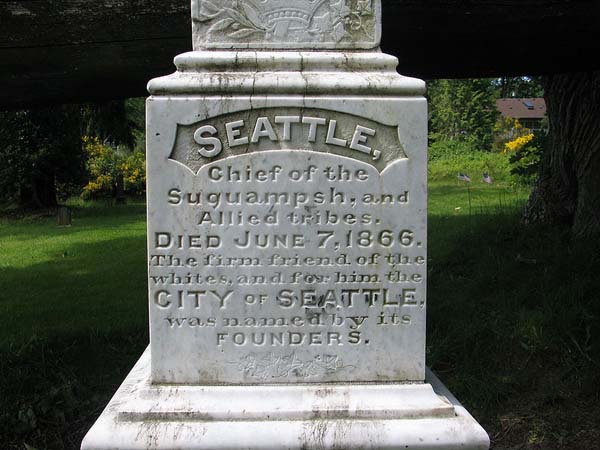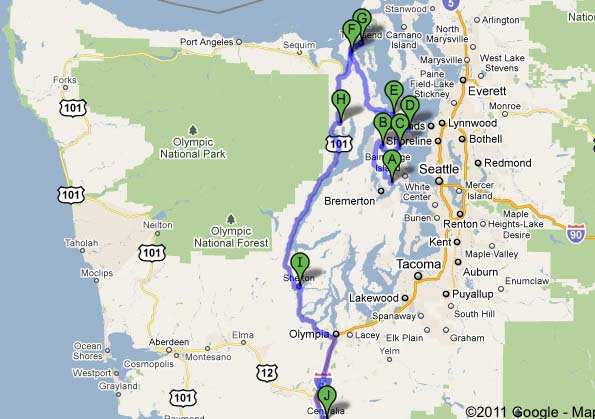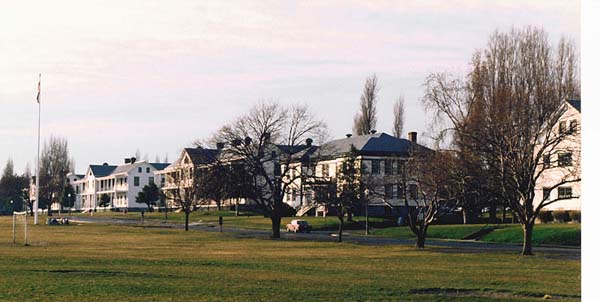The Travels of a Journalistâ€â€ÂÂ58-Journey to Port Townsend and return trip on U.S. 101
Posted on February 26th, 2011
By Shelton A. Gunaratne ƒÆ’-¡ƒ”š‚©2011Professor of mass communications emeritus@ Minnesota State University Moorhead
ƒÆ’-¡ƒ”š‚ Sunday (20 Aug. 1989) morning, all of us got up early to beat the rush for public washrooms at the Illahee State ParkƒÆ’‚¢ƒ¢-¡‚¬ƒ¢-¾‚¢s campgrounds. My mother said she relished sleeping in the tent flanked by her grandchildren Carmel, 5, and Junius, 9, just as our extended family did back in Sri Lanka. She confessed, however, that she did not have a good nightƒÆ’‚¢ƒ¢-¡‚¬ƒ¢-¾‚¢s rest because of the novelty of lying on the ground in a sleeping bag.
[Currently, the Illahee State Park offers 62 standard campsites, 41 utility campsites, showers, picnic areas, play area, game courts, swimming beach, boat launches, dock, hiking trails, and bike trails.]
We ate a quick campsite breakfast that Yoke-Sim served, dismantled and packed our tent paraphernalia, and left the park about 8 a.m. bound north to Port Townsend (pop. 8,334) in Jefferson County on the Canadian border, some 65-70 miles from Illahee, at the mouth of the Puget Sound. The idea of exploring the Puget Sound terrain up to Townsend was mine. Junius, who was able to read maps, also relished geographical exploration. The others passively agreed to let the chief navigator decide what they ought to see.
ƒÆ’-¡ƒ”š‚ From Kitsap to Olympic
We drove through the unincorporated residential communities of Brownsville and Keyport to the Nordic town of Poulsbo (pop. 6,318) on Liberty Bay, where we stopped for refreshments and shopped for groceries at AndersonƒÆ’‚¢ƒ¢-¡‚¬ƒ¢-¾‚¢s Supermarket.ƒÆ’-¡ƒ”š‚ Known for its Poulsbo Bread, originally baked in the local bakery, its shops and restaurants maintain a Scandinavian theme. Jorgen Eliason, a Norwegian immigrant, founded the city in the 1880s. Incorporated in 1907, Poulsbo derived its name from the village of Paulsbo (meaning ƒÆ’‚¢ƒ¢-¡‚¬ƒ…-PaulƒÆ’‚¢ƒ¢-¡‚¬ƒ¢-¾‚¢s placeƒÆ’‚¢ƒ¢-¡‚¬ƒ”š‚) in Norway. Poulsbo reminded me of Solvang, a similar-sized community founded by Danish settlers in Santa Barbara (see Travels-34).
Next, driving six or seven miles along Liberty Bay in a southeast-northeast direction, we reached Suquamish (pop. 3,510), the burial place of Chief Seattle (1780-1866) of the Duwamish tribe, who pursued a path of accommodation with the European settlers. David Swinson ƒÆ’‚¢ƒ¢-¡‚¬ƒ…-DocƒÆ’‚¢ƒ¢-¡‚¬ƒ”š‚ Maynard, Seattle cityƒÆ’‚¢ƒ¢-¡‚¬ƒ¢-¾‚¢s primary founding father, was a ƒÆ’‚¢ƒ¢-¡‚¬ƒ…-specialƒÆ’‚¢ƒ¢-¡‚¬ƒ”š‚ friend of Chief Seattle.
Old Man House, the ƒÆ’‚¢ƒ¢-¡‚¬ƒ…-big houseƒÆ’‚¢ƒ¢-¡‚¬ƒ”š‚ that was home to both Chief Seattle and Chief Kitsap, lies just to the south of Suquamish on Agate Pass. Chief SeattleƒÆ’‚¢ƒ¢-¡‚¬ƒ¢-¾‚¢s gravesite is in the Port Madison Indian Reservation. Maynard was instrumental in naming the city of Seattle to honor Chief Seattle.
ƒÆ’-¡ƒ”š‚ Tombstone of Chief Seattle in Suquamish ƒÆ’‚¢ƒ¢-¡‚¬ƒ¢¢”š¬…” 20 June 2008
Source: Wikimedia Commons.ƒÆ’-¡ƒ”š‚ Photo by Daniel M. Short]
ƒÆ’-¡ƒ”š‚
Figure 1: Our 20-21 Aug. 1989 tour route from Bremerton to Port Townsend and the return trip to Centralia and Longview on U.S.101, A=Illahee State Park; B=Poulsbo; C=Suquamish; D=Kingston; E=Port Gamble; F=Old Fort Townsend State Park; G=Port Townsend; H=Quilcene; I=Shelton; J=Centralia.
ƒÆ’-¡ƒ”š‚ ƒÆ’-¡ƒ”š‚ About eight miles northeast from Suquamish, we stopped at Kingston (pop. 1,811) on Apple Tree Cove, the western terminus of the Kingston-Edmonds Ferry that crosses the Puget Sound Narrows. More than four million passengers per year make use of this major ferry service.
Another eight miles west and north, we arrived in Port Gamble (an unincorporated community) at the northwestern edge of Kitsap Peninsula. A 19th century logging town with more than 30 Victorian-style homes, Port Gamble represents one of the few remaining examples of company towns. Before we crossed the long and narrow Hood Canal Floating Bridge that connects Kitsap Peninsula with Olympic Peninsula, we visited the Of Sea and Shore Museum in the townƒÆ’‚¢ƒ¢-¡‚¬ƒ¢-¾‚¢s General Store Building. The museum displayed a huge collection of shells from around the world.
ƒÆ’-¡ƒ”š‚ Port and Fort Townsend
Then, off we drove some 27 miles north of the canal to Port Townsend at the northeastern tip of Olympic Peninsula. Port Townsend is adjacent to the Admiralty Inlet and a trio of state parks built on retired artillery installationsƒÆ’‚¢ƒ¢-¡‚¬ƒ¢¢”š¬‚Fort Worden (immediately to the north of Port Townsend), Fort Casey (on Whidbey Island) and Fort Flagler (at the northern tip of Marrowstone Island)ƒÆ’‚¢ƒ¢-¡‚¬ƒ¢¢”š¬‚for the protection of the entrance to Puget Sound.
We visited the 433-acre Fort Worden State Park, where we saw several restored buildings, including the Bell Tower, Manresa Castle, City Hall, the Courthouse and the Post Office. We took pictures in front of the architecturally eclectic Jefferson County Courthouse.
With map in hand, I understood that at Fort Worden we were looking north at the 95-mile-long Strait of Juan de Fuca that connected both Georgia Strait and Puget Sound to the Pacific Ocean while also separating Canada from the United States. (De Fuca was the Greek navigator who sailed in a Spanish expedition in 1592 to seek the fabled Strait of AniƒÆ’†’ƒ”š‚¡n.) The scene was entirely different from what I observed at the mouth of Milford Sound in New Zealand in 1981 (see TravelsƒÆ’‚¢ƒ¢-¡‚¬ƒ¢¢”š¬‚15).
As Wikipedia puts it, in addition to its natural scenery at the northeast tip of the Olympic Peninsula, ƒÆ’‚¢ƒ¢-¡‚¬ƒ…-the city [of Port Townsend] is also known for the many Victorian buildings, numerous annual cultural events, and as a maritime center for independent boat builders and related industries and crafts.ƒÆ’‚¢ƒ¢-¡‚¬ƒ”š‚
We walked in downtown Port Townsend to see the century-old Tree of Heaven and the Victorian buildings. We saw some of the historic homes such as the 1868 Greek Revival-style Rothschild House and the 1889 Victorian-style Ann Starrrett House (744 Clay St.) from the outside.
[ Historic buildings at Fort Worden in Port Townsend
Source: Wikimedia Commons. Photo by Joe Mabel]
ƒÆ’-¡ƒ”š‚ Port Townsend is also accessible via ferry from the Keystone ferry terminal on Whidbey Island, on the east side of Puget Sound.
Return journey
Having seen the Canadian border from the northeastern tip of the Olympic Peninsula, we had to backtrack five miles southwards on SR 20 to get back to the serene surroundings of the 367-acre Old Fort Townsend State Park, where we stopped for refreshments late morning on our way forward. We liked the ambience of the place so much that all of us decided to stop there again to eat our lunch as well.
The U.S. Army built this fort in 1856 but abandoned it from 1859 to 1876 as ƒÆ’‚¢ƒ¢-¡‚¬ƒ…-unfit.ƒÆ’‚¢ƒ¢-¡‚¬ƒ”š‚ƒÆ’-¡ƒ”š‚ The revived fort lasted until 1895, when fire destroyed the barracks. It became active again during World War II. Since 1956, the State Parks has run the facility for the enjoyment of tourists like us.
After lunch, we continued driving south along the eastern shore of Discovery Bay. At the southern end of the bay, we merged into the scenic Olympic HighwayƒÆ’-¡ƒ”š‚ (U.S. 101), which flanks the eastern boundary of the Olympic National Park. We stopped 15 miles further south at the Quilcene (pop. 591) Ranger Station to savor the magnificent beauty of the Douglas fir, spring blooming Pacific rhododendrons, Oregon grape and salal in the Olympic National Forest land.
Our next stop was Shelton (pop. 8,442), the administrative seat of Mason County, 54 miles to the south of Quilcene. Incorporated in 1890, the city was named after David Shelton, a delegate to the territorial legislature. Yoke-Sim, our team expert in food, splurged $14 to purchase a salmon from a vendor somewhere in the vicinity. We also took a photo of ƒÆ’‚¢ƒ¢-¡‚¬ƒ…-Tollie,ƒÆ’‚¢ƒ¢-¡‚¬ƒ”š‚ a 10-ton Shay locomotive adorning the city.
It was dinnertime when we reached Centralia (via Olympia), 43 miles south of Shelton. We decided to compensate my mother for all the dukkha (suffering) we caused her through my tanha (desire) for endless travel by treating her with a grand dinner at the Cousins Family Restaurant in the city that a black man founded.
We returned home to Longview on Interstate 5 at about 8 p.m. after driving 256 miles during the day.
The very next day (Monday 21 Aug. 1989), my mother left us to return to Australia.
(To be continued)


